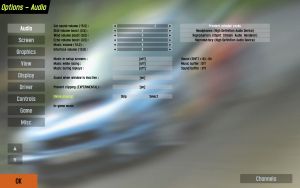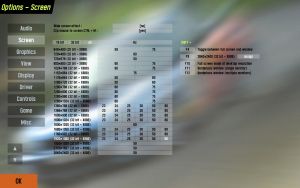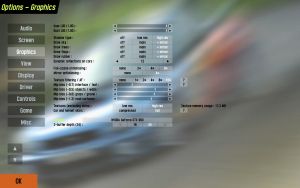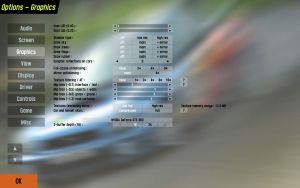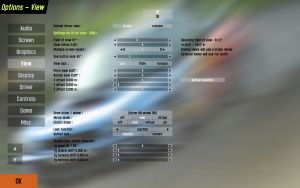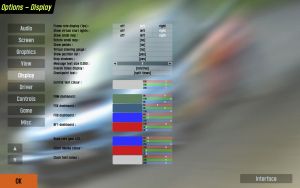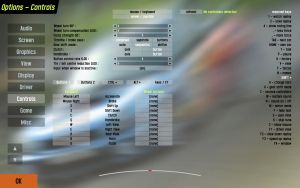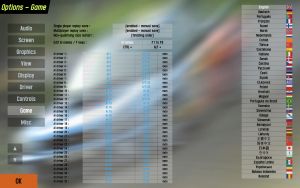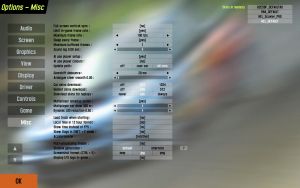オプション
Optionの項目は、新しいパッチが公開されると変更される場合があります。
Audio
このメニューによって、BGMといろいろな音量を変えることができます。
Car Sound Volume: 車の効果音(BGMとメニューの効果音に比例しています)
Skid Volume Boost: スキッド音のブースト(リアルスティックにするには「1.0」にセットして下さい)
Wind Volume Boost: 風の効果音(このセッティングに関係なく、オープンカーは風の効果音が非常に大きい点に注意してください)
Echo volume boost: エコーの効果量(デフォルト値は2.0)
'Music volume: メニューとレース中のBGM
Music in setup screens: セットアップ画面のBGMのオン/オフ
Music while racing: レース中のBGMのオン/オフ
Music during replays: リプレイ中のBGMのオン/オフ
Song choice: 『Skip』と『Select』で、BGMを選択できます。
In-game music: LFSはプレイリストをサポートしています。プレイリストを使用して曲目を変更できます。
Channels: プレイリストの作成、編集ができます。 チャンネル1は、すべてのセットアップスクリーンの規格であり、削除することができません。 あなたは、スクリーンの左のプレイリストを加えて、改名して、削除することができます。 右では、あなたは、道が歌を各道に割り当てると言い足して、道を削除することができます。 そして、そのaを確実にするために、あなたが最優先、1である3での優先権に持っているプレーされた後部が最も低い優先度であるつもりであったなら追跡してください、 道が自由に動くのを防ぐ設定。 歌の優先度が高ければ高いほど、それが再生されているのは、よりありそうです。 これは、あなたが聞く優先権の同じ両方の2歌がありましたら歌がしばしばequalyされるのを意味しますが、1曲には3の優先があって、もう片方に1の優先があると、あなたははるかに頻繁に最初の歌を聞くでしょう。
Channels: Using this button you will enter the interface for playlist creation and editing. Channel 1 is the standard for all setup screens and can not be deleted. You can add, rename and delete playlist on the left of the screen. On the right you can add tracks assign a song to each track and delete tracks. To ensure that a track will be played back you have to its priority with 3 being the highest priority, 1 the lowest priority and – the setting to prevent a track from being played. The higher the priority of a song the more likely it is that it is being played back. This means that if you have two song of the same priority you will hear both song equaly often but if the one song has a priority of 3 and the other a priority of 1 you will hear the first song much more frequently.
メモ: 音楽ファイルにはOgg Vorbisフォーマットを使用します。www.vorbis.comで利用可能なフリーウェア・エンコーダーを使用するか、その他のエンコーダーソフトで作成してください。 できたOggファイルを\Data\Oggディレクトリーに入れておいてください。
Screen
このメニューでは、解像度と色数、リフレッシュレートを選ぶことができてます。またキーボードに割り当てることも可能です。
Show non-square modes: ワイド画面など縦横比が4:3以外のディスプレイを使用するときに使われます。
Show 32.bit modes: 32ビット(約1670万色)の解像度の表示。32ビットにすると色数が増えますが、ビデオカードの性能が低ければ描画パフォーマンスが低下し、ビデオメモリの消費量も増加します。標準は16ビット(約65000色)です。
Wide screen effect: ワイドスクリーン・エフェクトの表示
Clip mouse to window: ウィンドウモードでマウスポインタが画面からはみ出ないようにします。もしマウスで車を操縦しているならば、これは重要です。Ctrl+Cでも変更できます。
Key assign: 解像度をキーボードに割り当てます。解像度と色数、リフレッシュレートをShift+F9~Shift+F12に割り当てることができます 。右側のボタンのうちの1つを選んで割り当てて下さい。
Graphics
このオプションは、グラフィックス品質の全ての秘密の握っています。このオプションを微調整することにより、フレームレートを上げたり、画質のクオリティーを改善することができます。いくつかの項目は、時代遅れのコンピューターにとって、ゲームのフィーリングを劇的に改善することができます。
User LOD: 物体とテクスチャーの品質が、距離に応じて変化する『詳細レベル(Level Of Detail)』の設定です。低い詳細レベルの場合、たとえばタイヤは角張って見えます。要するに遠くに表示される物体は省略されて表示されます。
パフォーマンス: 0.25 | クオリティー: 1.00
Dust LOD: 煙と砂塵の品質
パフォーマンス: 0.25 | クオリティー: 1.00
Mirror LOD: ミラーに写る物体の品質。『User LOD』とよく似た性質を持っています。
パフォーマンス: 0.25 | クオリティー: 1.00
Screen width affects LOD: 画面の解像度が『詳細レベル(LOD)』に影響するかの設定。1024x768より高い画面解像度が使われるとき、詳細のレベルも増えることになります。
画面解像度1024x768以下 – パフォーマンス: ON | クオリティー: OFF 画面解像度1024x768 – ON/OFF関係なし 画面解像度1024x768以上 – パフォーマンス: OFF | クオリティー: ON
Track LOD reduction: ONにするとパフォーマンスを非常に向上させることができます。いくつかの地形が距離に応じて非表示になります。画質にそれほどこだわらないのであれば、常にONにしておくのが良いでしょう。
パフォーマンス: ON | クオリティー: OFF
View
このオプションは、視点、つまりカメラを調節します。運転しやすいようにカスタマイズすることは、ラップタイムにも影響を与えるので非常に重要です。
Field of view: カメラの視野(ズーム量)。これはカメラのレンズを交換するのに似ています。値を小さくするとズームされ視野は狭くなり、望遠レンズを使った場合と同じになります。逆に大きくすると視野が広くなり広角レンズを使用した場合と同じになります。あなたの好みでバランス良く調節して下さい。デフォルト値は、90°辺りです。キーボードの5、 6でも変更可能です。
以下の4つの項目は、スタンダードビューとカスタムビューの両方で、Gフォースによる頭と体の影響度を設定します。0に設定するとカメラはGフォースの影響を受けません。
1g head tilt: Gフォースによる頭の傾き量
1g lateral shift: Gフォースによる体の左右の移動量
1g forward shift: Gフォースによる体の前後の移動量
1g vertical shift: Gフォースによる体の上下の移動量
Default Driver view: LFSには2つのカメラモードがあり、スタンダードビューは最もリアルスティックなモードで、カスタムビューは好きなところに自由に配置できます。カスタムビューの設定方法は、後ほど説明しましょう。
これらのうちの1つをここで選ぶことはそのあなたがLFSを始めるとき、自動的に選ばれる標準的な見解であることに終わります、レースと缶の始めに、プレスSHIFT + F1でアクセスされてください。
ここの見解を選ぶ、車または習慣において、あなたはほとんど使っています。
Selecting one of these here will result in that being the standard view wich is selected automatically when you start up LFS, at the beginning of races and can be accessed by pressing SHIFT + F1.
Select the view here wich you will be using most of the time, in car or custom.
Pitch view: The vertical direction of the camera can be selected here, it can aim upwards with a positive value, or it can aim downwards with a negative value.
Rotate view: The horizontal direction of the camera. It can aim left with a negative value or aim right with a positive value.
The mirror offsets: Adjusting these will position the front mirror horizontally (mirror offset lateral) and vertically (mirror offset vertical). Make sure it's visible as it's useful tool to notice cars behind you.
Clocks mode: This defines how the car's gauges and meters are displayed. Off displays nothing, real shows them on the car's dashboard and virtual shows them on your display.
Move view with animation: This option allows you to select whether the incar camera moves along with the driver when it steers left and right, which does look realistic, but it's personal whether it should be on or off.
Draw driver / wheel: This changes what you see in the incar view. The driver with the steering wheel, only the steering wheel, or nothing at all. Some people who use a steering wheel in LFS are known to use display no steering wheel in LFS because it looks awkward seeing a steering wheel move the same as the one you are controlling.
Look function: With this option, you can set up additional ways to look left and right beside the look left and right buttons. The Axis option will move the camera left and right with an axis specified in the Controls menu. Read that to get to know how to set an axis for the axis look option. The steer option will move with your steering. Steering left will result in the camera moving left as well. This can be pretty usefull as when you steer left, you will want to go in that direction and a view looking into that direction shows more of what to come. The amount the camera looks into the steering direction can be adjusted with Look sensitivity. To find a good value for the sensitivity, steer all the way to one side and adjust the Look sensitivity to what is the maximum allowed amount of movement to one side. Ms X will move the camera left and right along with the mouse. Look sensitivity does the same as described above. Look centre reduction will alow you to define how easily the camera should stay in the forward looking position. Setting it at a high value will result in having to move the mouse alot to move it out of the forward looking position. At a low value, it will move exactly like the mouse with no centre movement reduction. Ms XY does the same except the camera moves up and down with your mouse as well, making it more adjustable.
Button look: Setting this option will define how the camera should look left and right when you press the Look left and Look right buttons specified in the Controls menu. Smooth will pan the camera gently to the side when you press the button, instant will show you the side inmediately without movement.
Setting up a custom camera
(Note: every custom camera you set up is saved per car. This way you can make a different custom camera in every car.)
Go to the View options and click on custom in the Default driver view option. Notice that new options are available now called Settings for custom view.
The Style option adjusts how the car itself is displayed. No draw shows no car at all, wheels shows only the wheels, external always shows the car wich is the most realistic and ext.2 is the same as external but it does not show the car when you look left or right with the look left and right buttons.
Clocks mode: This defines how the car's gauges and meters are displayed. Off displays nothing, Real shows them on the car's dashboard and Virtual shows them on your display.
The X offset, Y offset and Z offset, the most important settings of a custom view, define the custom camera's position. X offset moves the camera left and right, Y offset moves the camera forwards and backwards and Z offset moves the camera up and down.
Pitch view: The horizontal direction of the camera can be selected here, it can aim upwards with a positive amount, or it can aim downwards with a negative amount.
Rotate view: The vertical direction of the camera. It can aim left with a negative value or aim right with a positive value.
The mirror offsets: Adjusting these will position the front mirror horizontally (mirror offset lateral) and vertically (mirror offset vertical). Make sure it's visible as it's useful tool to notice cars behind you.
An example of a nice view in the XF GTI:
Style set to external, X offset to -0.315, Y offset to 0.547, Z offset to 0, Pitch and Rotate to 0.
When you are done setting up a custom camera, click in car again in the Default driver view option if you want the default view to be used as the standard view. Though, if you are happy with the new custom view, keep it on custom so it will always be used as the primary view.
View buttons and shortcuts
V : Switches through the cameras.
SHIFT + V : Switches back through the cameras.
TAB : Switches to the next car.
SHIFT + TAB : Switches to the previous car.
HOME : Switches to your own car.
SHIFT + F1 : Returns to the default view specified in the View options.
SHIFT + F : Removes the display showing only graphics and text messages.
SHIFT + M : Changes between mirror modes. (No mirrors, only real mirrors or real mirrors + a virtual mirror.)
SHIFT + U : Switches to the AutoX editor/Free view -mode.
Display
Here we can change the speedo, type of mirror used, add a map of where we are on the track.
Frame rate display: You can choose to have your rate displayed or not
Digital speedo: Yes or No toggle
Mirrors & clocks: Off means none displayed. Virtual means a virtual display on screen, not on the mirror itself or dash. Real means display where they should be, mirrors on mirrors, speedo etc. on dash.
Drop shadows: None = Off, Text = Text only, All = everything
Message size: Adjusts the text displayed in game etc, 0.70 is about the right size to start with.
Display results: Shows a transparent panel that updates and shows lap time differences etc, you can turn on or off here or toggle with Strg + Tab toggle
Overall times display: Absolute shows most recent gap time for each car compared to each other car. Relative shows the individual gap between each car relative to the lead car.
Manual shift indicator: Set to show upshifts only, downshifts only or leave to show all shifts or not display them at all.
Player
In this menu, details such as screen name, number plate text, country personalised and preferred language etc. can be added. Here you can also select your driver, Male or Female, complete with helmet and racing suit and add to your car’s cockpit. Your selected screen name will always appear next to the player button, you can also change helmet and helmet colours.
Controls
Mouse/Keyboard
Button control rate: This is for when you assign a button to an analogue control (e.g. handbrake or clutch) how fast the control moves when the button is pressed. Higher is faster.
Keyboard steer: keyboard - no help / keyboard - stabilised / mouse steer toggle. This is how you select your input method:
Mouse steer (rather obviously) lets you use the mouse for steering and assign throttle and brake to buttons (be they on your keyboard or your mouse).
Keyboard - no help directly translates button presses into wheel movement. So long as the button is held down, the wheel will continue turning until it reaches maximum lock. There is an auto return to centre function when no steering keys are pressed. Both rates are configurable. Also, pressing both left and right will hold the wheel in its current position. This steering method is definately not recommended, since it is impractically difficult to race with.
Keyboard - stabilised has two main differences to "keyboard - no help". Firstly, it limits the movement of the wheel depending on the amount of grip the tyres have. This limit is also adjustable. Secondly it adds a small amount of automatic countersteering to help balance the car. While this is a driving aid (and the turn limit can be considered one as well), it is essential for using such a basic input device for a task it obviously would never be used to do in real life. Thankfully the keyboard steering is highly configurable in LFS so you should be able to get it to work to your preference.
Auto gear shift: Yes or No toggle. If enabled, the computer will change gear for you (and probably at the wrong time too).
Mouse steer only:
Steer centre reduction: This is a non-linearity slider and is designed to make it easier to control the car buy reducing straight line twitchyness. A setting of 0.0 gives fully linear steering whereas a setting of 1.0 gives fully non-linear steering. A setting of 0.4 to 0.6 is recommended.
Keyboard steer only:
Steer rate: The speed the wheel turns when you press the left or right steer buttons. Higher values will make the car more responsive but less stable, and vice versa.
Return rate: The speed the wheel turns when you depress the left or right steer buttons. Higher values will make the car more responsive but less stable, and vice versa. It is usual to use a lower value for the return rate, between 50 to 75% of the steer rate.
Fast steer multiplier: When holding the "Steer Fast" key, the steer rate will be temporarily increased. This slider controls by what percentage it will be increased. With the default setting of 2.00, the steer rate will be doubled. This fast steering option can be useful when quick corrections are needed, such as when countersteering. Chances are you're going to crash anyway so this option is of limited helpfulness.
Slow steer multiplier: When holding the "Steer Slow" key, the steer rate will be temporarily reduced. This slider controls by what percentage it will be reduced. With the default setting of 0.50, the steer rate will be halved. This slow steering option is most useful at higher speeds when finer control over the vehicle is needed. However the keyboard steering is automatically speed sensitive, so there is really no need to ever use this anyway.
Limit multiplier: A setting of 1.0 limits the wheel turn to that of the available grip of the tyres. Settings higher than this allow you to turn further, to induce understeer. Settings lower than 1.0 means you won't get so close to the limits of the car, so control is retained. The further you reduce this setting, the easier the car will be to drive, at the sacrifice of cornering speed. (available with Keyboard - stabilised only)
In the Buttons 1 subsection you select which button to assign to the function labelled to the right of the button. To choose and lock in your selection, simply click on the button to highlight it, a text message with instructions will appear at bottom of screen, Click desired button or key you wish to associate with this button etc. Do this for all Button 1 selections, then move on to Button 2 section using the same method to select and assign your desired keys or buttons to control the views etc.
When you have completed this, mouse users and keyboard users are finished, and may want to skip the section on wheels and joysticks. And go directly to the far right of this screen and look closely at the various key sequences and what they do. i.e. (Reserved keys) and Shift + combinations.
Wheel/Joystick
This section provides different options additional to the previous section. Existing keyboard and mouse settings can still be used just by clicking on the Mouse/KB button. This is useful if your wheel breaks or springs in pedal fall apart.
After selecting to enable your wheel you will need to set it up for maximum efficiency depending on the make and whether is has force feedback functions etc some options will not be needed or may be used if desired. Please note that you might have to change some settings in the drivers of your wheel manufacturer, e.g. to enable split axes.
Steer center reduction: Adjusts the turn ratio of the users wheel to the LFS car.
Force strength: For FF users, higher settings mean more feedback. Just try what suits best to you.
Throttle/brake axis: Can be one of three different states:
Combined: The brake and throttle use the same axis
Seperate: The brake and throttle use one axis each for their settings
Button: The brake and throttle use can be assigned to a button or a paddle
Shift type: We have discussed earlier the three types and their use.
Clutch & Handbrake: Can be assigned to any spare axis or button if you wish.
Throttle/brake centre reduction: Adjusts the sensitivity of the throttle and brake and the point at which it starts to apply.
Setting up the wheel
This is the area where wheel and joystick users get to assign the axis. Again most of these options are largely a click and set type button. Firstly please make sure your equipment is attached to the computer and windows has found the device and it has been set up in Control Panel / Game Controller area. Run your profiler software if needed and deselect combined axis at a windows level if needed. Calibrate using windows software before attempting to setup in LFS.
When you arrive at the controls screen shown above you be able to choose a range of options from those available to make your wheel or joystick work best with LFS. To select an axis click on the button lets start with Steer: Highlight steer and you will notice the panel available axis will light up from there you can choose which of the axes to use. The bar next to the axis will show you the range of motion of the mapped device and is used to calibrate. Highlight and select as many or as few as you wish.
For those with a force feedback controller you must enable the Force Feedback to allow any previous settings to take effect – when finished you will need to test that each axis is correct and not reversed as sometimes controllers are wired different to normal and your brake or accelerator may be on all the time. If you then choose recalibrate you can then turn the wheel or joystick left & right to determine the maximum limits and see if you have maximum settings on throttle etc. If the settings are indeed reversed use the invert button next to the selected device to reverse polarity. Have a play with these settings and you’ll soon get the hang of the controls.
For the steering wheel turns for each car, see this page
Game
Here we set some minor options such as the automatic/manual saving of races, the finishing order for race restarts etc - We can substitute names for the AI, maybe we want to race against Peter Brock or Michael Schumacher? Just click to cycle through the available options of each selection. The most important feature however, is the ability to add to the F1 - F8 keys of your own custom messages, such as “Sorry”, Hello, etc for use when in game and too busy to type a reply etc. To do this, select the "F1 to F8" button and in the space next to the selected key, click to open, then type in your message text, click OK to save. There is a limit on length etc, but most short messages can be written.
On the right side of this page you can select the language used in LFS.
Single player replay save: Not enabled / Enabled / Auto save. Sets how replays should be handled. Not enabled means there are no replays recorded, ever. Enabled means replays are recorded, but you have to save them manually (ingame, hit "1" to save with automatically generated name, or hit "2" to save with custom name). Automatic means that every replay is saved with an automatically generated name, without requiring you to do anything.
Multiplayer replay save: See single player replay save.
Non-qualifying race restart: Sets how race (re)starts that had no prior qualifying should be handeled. The options are self explanatory.
Edit AI names / F keys:
AI names - Self explanatory.
F1 to F8 - Click on the spaces/buttons right to the desired key to define the text to say on hitting the corresponding key. The codes in there are the same as if hitting "T" (to talk) ingame.
CTRL + - Same as behaviour as in "F1 to F8", but defines the actions when hitting CTRL plus the desired key at the same time. Additionally you have access to keys F9 - F12 here.
Misc
There are seventeen (17) different options here! Including some things that make a difference to game play and frame rates.
Full screen vertical sync: On/Off toggle
Limit frame rate in game: On/Off toggle, this is used in conjunction with the next option to set what max frame rate to use.
Maximum frame rate: Here you can set a minimum / maximum number of frames for use in game – depends upon the previous setting to enable/disable.
Minimum sleep: You select time value. This setting forces LFS to sleep/wait the set amount of time between each frame, to allow Windows to update controller inputs, etc. Increase this value if you're having problems with controller stuttering/lag or similar. Don't put it too high, though, as it will limit your maximum framerate.
Screen clear type: Ellipsoid and Clr+Sky are the same quality but just drawn in a different way to allow for what’s best with different cards. Usually it makes no difference but choose the one which gives the better frame rate. Plain draws no sky, which can increase your framerate on older systems.
Log messages: On/Off toggle - this option will keep a log of all the text chatter between players.
AI use player setup: Self Explanatory
AI use player colours: Self Explanatory
Sound lag: Because the program has to play the sound slightly in advance, so that there are no gaps in the sound. Recommended setting is as low as possible without hearing stutters or gaps in the sound.
Analogue steer smooth: Sets the amount of smoothing for joysticks and some wheels. The higher the value, the smoother your inputs will be, but they will also lag behind slightly.
Multiplayer speedup option: This options makes the distant cars use less cpu by not updating their physics or drawing them at all. It’s disabled when you view from the TV cameras because frame rate isn’t so important then..
Multiplayer car draw: Only visible when the above option is enabled. Sets the distance the cars are drawn. Use a lower value for increased framerates.
Dynamic LOD reduction: Sets the value for the dynamic change of "Level of Detail". Zero means no, and one is full dynamic LOD reduction. This makes the Level of Detail change dynamically depending on how many cars are visible and on your current framerate. Use higher values if you experience slowdowns when multiple cars are visible.
Update path: 3 options – Off, User car or All cars - This determines which cars update the rubber mark on the track - the racing line rubber.
Load track when starting: Yes/No toggle. If disabled, the startup time of LFS will be considerably decreased.
Local time in 12 hour format: Self Explanatory
Show time instead of FPS: Yes/No toggle. If on, the FPS display (see Options - Display) will be replaced with the local time.
